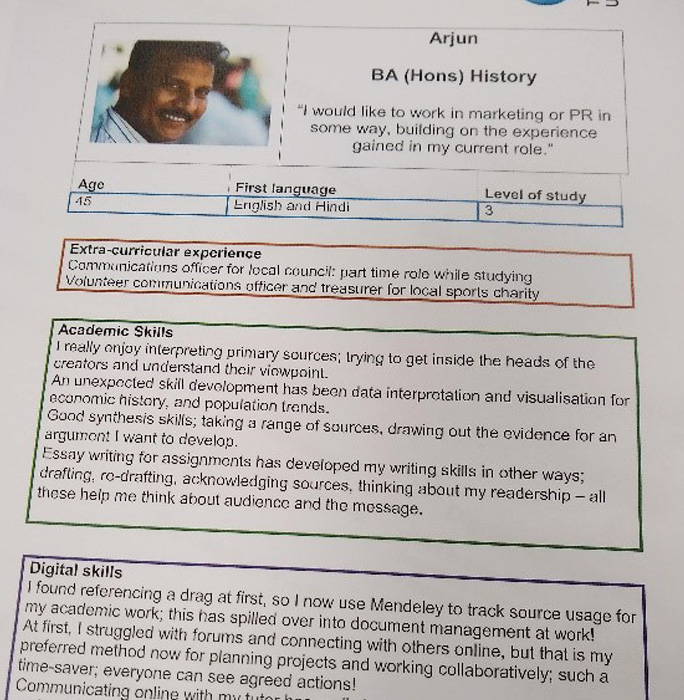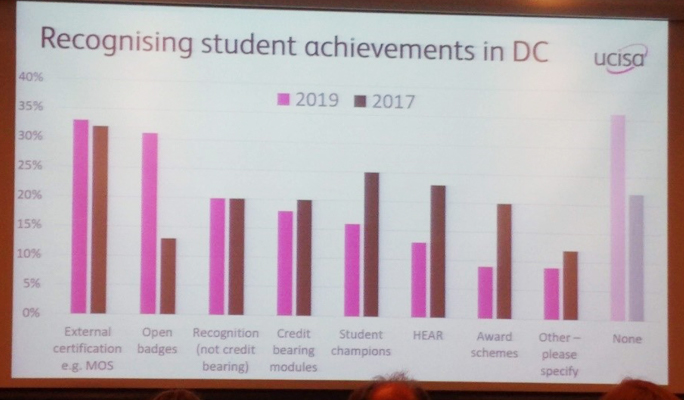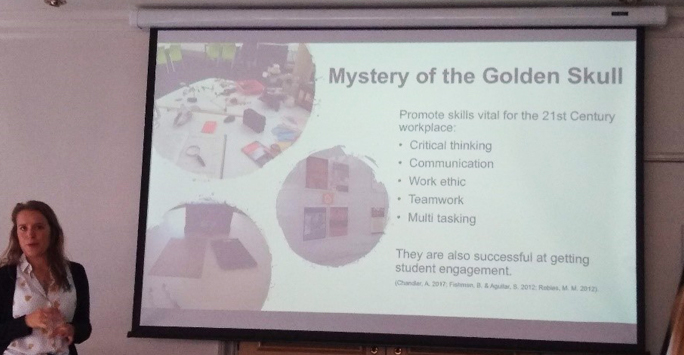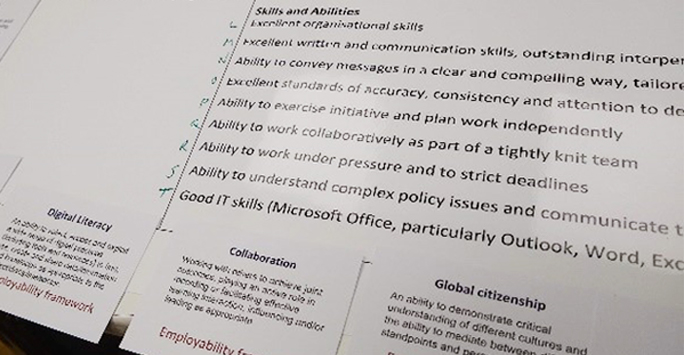UCISA Digital Capabilities - York 4th - 5th June 2019
Posted on: 21 June 2019 by Tunde Varga-Atkins in Conference & Event Reports

Tunde Varga-Atkins attended UCISA’s Digital Capabilities Group’s annual spotlight event on 4-5th June 2019 in York, exploring student, staff and institutional perspectives of developing digital capability. She provided this report.
What is the event?
As a UCISA conference first-timer, I attended UCISA’s Digital Capabilities Group’s annual spotlight event, exploring student, staff and institutional perspectives of developing digital capability. Participants included a cross-section of institutional departments, including IT and computing services staff, learning technologists, library staff and educational developers.
An overview of the days:
We had two days full of activity, a mixture of presentations and active learning sessions. I have summarised my highlights below – if you want to save time, just skip to the ‘what did you get out of’ section.
1. Microsoft Teams as inclusive learning environment
It was useful to hear the exciting implementation of Microsoft Teams for learning by Dale Munday, Digital Learning Facilitator, Lancaster University who discussed their UA92’s university’s use of Teams as a VLE supporting an inclusive curriculum and developing pedagogic approaches to teaching, learning and assessment, including:
- Being able to connect to other MS tools and external tools from within Teams without student having to leave the environment.
- Using MS Stream which transcribes screencast feedback – brilliant for accessibility, similarly interactions can be used with an immersive reader converting text to audio.
- Using NearPod which is great for students’ note taking and creating their own content.
- The ‘Conversations’ tool is used for asking questions during lectures, promoting active learning.
2. Workshops are not enough: accessibility and inclusive practice
Laura Hollinshead, Learning Technologist and Claire Gardener, Senior Learning Technologist shared their approach at the University of Derby on getting staff on board with the accessibility and inclusive agenda. Their key messages were:
- We all have a role in driving the accessibility agenda, workshops are not enough, but institutions need institutional, accessible templates and senior managers who drive the accessibility agenda.
- Three things staff need to think about who support student learning:
- Why is accessibility important? The stick is the regulatory requirement coming into effect by 2020 September (latest!!). But more importantly accessibility should be about our social responsibility to students and staff. Finally, paying attention to accessibility and inclusion cold be helpful for TEF measures such as the attainment gap between students with no declared disability (80%) and those with (77%).
- What is accessibility? Some staff misinterpret accessibility for availability. Just because something is online, it does not mean the content is accessible to everyone. Learning resources also need to be inclusive, i.e. available in different formats so that anyone with various disabilities is be able to interact with it.
- How? We need to develop staff so that they can recognise what the accessibility problem is and know how to fix it.
- How is the University of Derby preparing to meet these requirements?
- Combining inclusivity together with their various strategies (TEL, Assessment&Feedback);
- Offering curriculum development support;
- Delivering workshops, helping academics develop content/courses which are accessible.
- Buying into Ally from Blackboard (which works across different VLEs) to help monitor accessibility of VLE content through a rating systems, which offers advice on how staff can improve on the accessibility of their resources.
- Although Ally produces a ‘red’ notification for accessibility issues in modules, Laura and her team found that staff needed support in interpreting the Ally-produced accessibility report.
- I loved this suggestion from Laura connecting inclusivity with employability from the student perspective: “We should upskill and train students so that they are aware of accessibility of creating learning resources so they are aware when they get into employment.”
- Laura’s other tip was to find advocates to drive the inclusive agenda. She found that demonstrating the experiences of those having to use assistive technology when faced with inaccessible learning resources was very effective.
3. Looking for that ‘extra’ on graduates’ CV: certification of digital capabilities (IT/multimedia skills)
A number of institutions, including Phil McMillan, Learning Technologist and Chris Melia, Senior Learning Technologist, University of Central Lancashire, are implementing ways in which to offer students something ‘extra’ with respect to digital capabilities on their CV to make them stand out. They have had a sharp rise (from 155 to 1500 participants) in students taking up their free courses on as Microsoft Word, Excel, PowerPoint and graphic design software such as Adobe InDesign and Illustrator; partly due to more staff resource available, extending the range of courses offered and branding them as tailored to student needs, e.g. workshops on Word for dissertations or PPT for creating academic posters. Phil and Chris also talked about their internal Digi-ready certification and recognition system developed for staff - offering Digital Practitioner, Advocate and Champion status. The student-facing Digi-ready project supports students with putting together a portfolio of their digital skills.
4. An issue of language: employability and digital capabilities with one stone
(Mapping digital capability statements against the skills&attributes section of a real job description (from Wendy Mear’s session, OU))

(Working out how/if the student matches the required digital skills of the above job description (from Wendy Mear’s session, OU))
Wendy Mears, Learning and Teaching Librarian, The Open University, facilitated one of the best interactive sessions of the conference. Wendy mapped the learner profile from JISC’s digital capability framework onto their employability and digital/information literacy strategy and pointed out the overlaps and that agreeing or traversing between terminology can help students articulate what capabilities they gain during their study. In the session we were asked to map the capability statements against a real job description (e.g. a public affairs officer). This mapping process took a lot of interpretation. Finally, we consulted a student profile detailing their experiences to see if we would give them the job. I loved this mapping and profiling exercise and the approach to help staff and students highlight and interpret where digital capabilities might be present in various job roles and criteria.
5. Self-reflection and developmental toolkit for staff and students @Plymouth
This session was a lovely surprise as the Plymouth team was on my to-contact list about their use of PebblePad for developing students’ digital capabilities via a consistent cross-institutional support. Loretta Cook, Digital Skills Developer and Emma Purnell, Senior Learning Technologist, Plymouth University gave us an insight into the environment they developed based on JISC’s role profiles (Learner, Teacher and Professional Services):
- Loretta designed a toolkit aimed at Professional Services staff to improve their digital capabilities. She said it was important to give staff their own space to develop their skills personally and to do it without prying eyes of managers in a space only available to them, which is why they used PebblePad for this. They developed the toolkit according to staff members’ journey, e.g. induction, probation, ongoing development, role specific skills and recent technologies.
- This toolkit was promoted to new managers to use with their new staff, who have the option to share their results or areas for development within their PDR process. Managers found that having this toolkit was useful for supporting staff induction.
- The student digital capabilities toolkit was developed slightly differently, according to the student journey, starting with the ‘Getting started’ section (including a self-test and reflection with signposting students to further resources where they have identified gaps), then students can complete another section at the end of Sem 1. The student toolkit is generic to all disciplines BUT discipline-specific elements can be (and have been) added to it, which can be pushed out to all relevant students via PebblePad. Each section in the learner profile closes with a Likert scale with skill level for reflection and action plan, which is a strength of the toolkit.
6. Report from UCISA’s Digital Capabilities Survey 2019
Gareth Johns, IT Skills Development Advisor, Cardiff Metropolitan University, reported on the very fresh UCISA Digital Capabilities Survey results, published on the same day of the conference. The key take-away message for me were the following three highlights currently on institutions’ agenda with respect to digital capabilities:

(Highlight from the UCISA report, 2019)
- Accessibility and how to meet the EU directive and regulatory requirements;
- How to offer certification of digital capabilities for students so as they are recognised by employers (HEAR has been pushed more to the background and digital badging is gaining traction, though badges are also contentious as can range from ‘mickey mouse’ to highly and widely respected certifications e.g. issued by the OU, Microsoft Office, Oracle and Adobe. One recommendation is that UCISA develops institutional badges as a means for accrediting and rewarding student achievement for digital capabilities.
- Finally, a recurring theme is the integration of digital capabilities in the curriculum, which shows that having digital fluency as one of our C2021 attributes at the University of Liverpool is worthwhile.
7. Increasing digital capabilities through game-based learning

(Charlotte Ellis presenting on how they used an escape room to induct staff about learning technology systems at the University of Derby)
I was somewhat disappointed that instead of taking part, we instead heard how Charlotte Ellis, University of Derby, designed an Escape room for their PGCert staff to initiate them into the technologies which were available to them at their University. But having realised the complexity and sheer planning which had gone into the design and having seen pictures of the various props and artefacts used, I understood that it would have taken hiring a whole train to transport them to Derby! Thanks to Charlotte’s storytelling skills, I got inspired by the idea of introducing staff to new technologies through this fun activity:
- Staff in small groups have to solve the mystery of who stole the golden skull from the room. Teams conduct a police investigation using various artefacts and props. As they step through the 45-minute process, teams are exposed to or having to engage with technologies to which the university has access, including AR, VR, lecture capture software and in-class polling systems supported by the facilitators who can offer clues. The session closes with a debrief where participants discuss the technologies used and issues or questions which emerge.
- Careful testing (testing, testing and testing!), preparing, piloting and facilitating, managing team dynamics and over-competitiveness were all recommendations.
- The best bit about this activity that it inspired lecturers to try this game-based idea in their teaching on a journalism course and in the business school.
8. Approaches to developing staff and students’ digital capability
Heather Price from JISC shared their new services and toolkits to support staff and students’ digital capabilities. JISC’s building digital capability service involves a range of different offerings. At senior leadership level, the Digital leaders programme is running between 9-10 and 23-24 October.
The JISC discovery tool seems a very pertinent service, a developmental tool aimed at students and staff. Once an institution subscribes to it, students and staff can complete their relevant reflection of their digital capabilities tailored to their role. The tool is linked to a resource bank, which can be customised to harvest locally available resources, such as LinkedInLearning (Lynda.com). Once the user completes their reflection, they are signposted to these resources and can receive a downloadable report which is for their personal benefit; although they can choose to share it if they wish. From an organisational perspective, anonymised aggregated data can be available to indicate response dates and aggregated ratings by departments. A free taster version of this the toolkit available and an accessibility package is being added in ready for the accessibility regulations. I definitely think the Discovery tool is worth exploring for us @LivUni as it is a ready-made, well-researched tool which staff could offer to students either within and alongside the curriculum, and as it is also aimed at staff, it could address the gap in areas in which staff feel they need to develop their digital capabilities.
9. How do we design for developing digitally fluent professionals?
Finally, just to plug my own session, I presented findings from my doctoral study on digital capabilities of engineers and managers – although the main aspect I wanted to share with was my research process of how we could work with different disciplines to co-construct what digital capabilities mean in their respective field of expertise. The slideshare of my presentation is available.
What did you get out of the conference?
My key take-away messages from the UCISA conference on digital capabilities were:
- Accessibility of learning resources & certification of digital capabilities of both staff and student are two hot-topics on institutions’ agenda.
- We should explore JISC’s discovery tool to see if it could help support our digital fluency agenda @LivUni, especially that accessibility is being added to it as a developmental area.
- Would love to invite the team from Plymouth to showcase their use of PebblePad.
Final thoughts:
Although pretty much everyone had a different job title amongst the participants of the conference, it was heart-warming to see all the sharing of experiences and expertise and resources people have developed in their institutions, as well as our common goals to create an inclusive educational experience for students.
Further information:
UCISA Digital Capabilities Special Interest Group
UCISA DCSIG Spotlight event including programme and speakers
Screenshots from the event – see also Twitter #UDigCap
Keywords: Digital Capabilities, Accessibility, Inclusivity, Certification, Employability, UCISA, JISC, Microsoft Teams, Escape Room.
